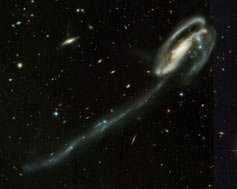

Monday - October 15, 2007
SLAC Today is
available online at:
http://today.slac.stanford.edu
In this issue:
Exposing the Nature of Cosmic Liaisons
Colloquium Today: Mega-masers, Dark Energy and the Hubble Constant
SLAC Walk and Run Scheduled for Nov. 15
 |
 |
|
Monday - October 15, 2007 |

Risa Wechsler has developed a new tool for measuring how galaxy interactions, such as that which drew out the trail of stars in the Tadpole Galaxy (pictured here), affect the rate of star formation.
Exposing the Nature of Cosmic LiaisonsRisa Wechsler of the Kavli Institute for Particle Astrophysics and Cosmology (KIPAC) and her collaborators have devised a powerful technique to study how interactions between galaxies affect star formation. Their results shed light on the fundamental processes that drive galactic evolution. In the early universe, the rate of star formation was higher than it is today. Galaxies frequently collided and coalesced with one another, spawning a profusion of new stars with each encounter. Although such prolific events are now relatively infrequent, less spectacular galactic interactions continue to forge stars and shape galaxies. Observational studies suggest that even these interactions increase the rate of star formation, but there is little consensus on the frequency and magnitude of such events. "To study this, you need to observe pairs of galaxies, which have either just interacted or are about to interact, and determine whether their star formation rate is higher or lower than similar galaxies that haven't interacted," said Wechsler, who collaborated with researchers from the Center for Cosmology at the University of California in Irvine and the University of Chicago. Although the idea is straightforward, its execution is problematic. Galaxy interactions are highly complex and dynamic, and observation yields a mere snapshot of the unfolding events. Read more... |
||
|
|
||

Mega-masers,
|
SLAC Walk and Run Scheduled for Nov. 15
On November 15, more than particles will be speeding along SLAC's linear accelerator. Both sprinters and amblers will travel up and down the Klystron Gallery, taking part in a 36-year old laboratory tradition, the SLAC Run and Walk. In 2006, event planners had to scramble to make the event happen when construction blocked the normal route. "This year, things are looking up," said Race Committee Member Ruth McDunn. Runners are back on the usual 3.8-mile track, and top finishers will receive prizes. The noncompetitive walk event covers a two-mile course. Registration starts at 11:45 a.m., on the north side of the Klystron Gallery at Sector 30. Every year the committee designs an event t-shirt that incorporates current events at SLAC. The 2007 shirt illustrates construction of the Linac Coherent Light Source and is a light ash gray. Shirts are $12 each. T-shirts will be available at the race event, but McDunn recommended that those who want a small, medium, or XXL size pre-order as those shirts are often in limited supply. More information is available at the SLAC Run and Walk website. |
Events (see all | submit)
Access (see all)
Announcements
|
| | ||
|
|
||
 <%
Response.AddHeader "Last-modified", getArticleDate()
'Response.AddHeader "Last-modified","Mon, 01 Sep 1997 01:03:33 GMT"
'Monday, December 06, 2010
%>
<%
Response.AddHeader "Last-modified", getArticleDate()
'Response.AddHeader "Last-modified","Mon, 01 Sep 1997 01:03:33 GMT"
'Monday, December 06, 2010
%>View online at http://today.slac.stanford.edu/. |
||